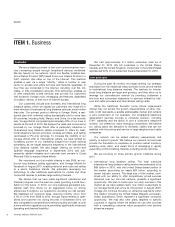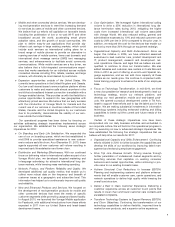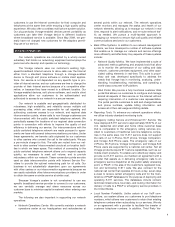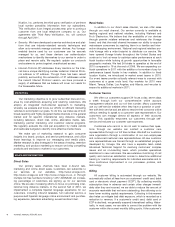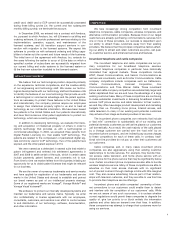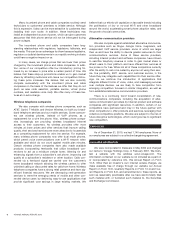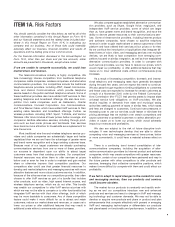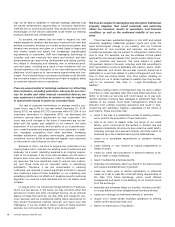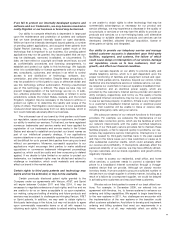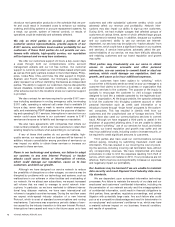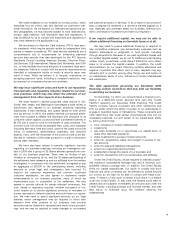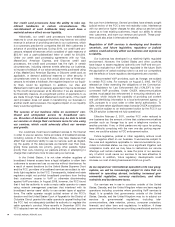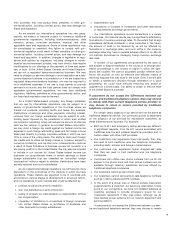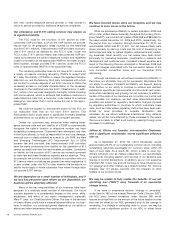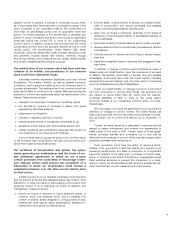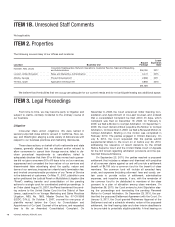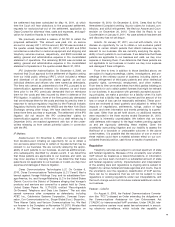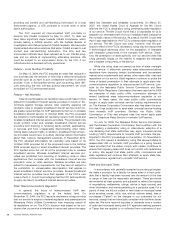Vonage 2010 Annual Report Download - page 17
Download and view the complete annual report
Please find page 17 of the 2010 Vonage annual report below. You can navigate through the pages in the report by either clicking on the pages listed below, or by using the keyword search tool below to find specific information within the annual report.may not
b
ea
bl
e to esta
bli
s
h
or ma
i
nta
i
n strateg
i
ca
lli
ances t
h
at
will
p
ermit enhancement o
pp
ortunities or innovative distribution
methods for our
p
roducts and
p
lans. New
p
roducts based on new
technolo
g
ies or new industry standards could render our existin
g
p
roducts obsolete and unmarketable.
T
o succeed, we believe that we need to ex
p
and into ne
w
market se
g
ments, develop new sources o
f
revenue
f
rom new an
d
existin
g
customers, enhance our current products and plans, and
develop new products and plans on a timely basis to keep pace
with market needs and satis
f
y the increasin
g
ly sophisticated
r
equirements o
f
customers. VoIP and messa
g
in
g
technolo
g
yi
s
com
p
lex, and new
p
roducts and
p
lans and
p
roduct and
p
lan
enhancements can require lon
g
development and testin
g
periods.
Any delays in developin
g
and releasin
g
new or enhanced prod-
ucts and plans, includin
g
as a result o
f
any limitations with ou
r
internal systems or the inte
g
ration o
f
our new orderin
g
and billin
g
p
lat
f
orms, could cause us to lose revenue o
pp
ortunities and cus
-
tomers. Any technical
f
laws in products we release could diminis
h
the innovative impact o
f
the products and have a ne
g
ative e
ff
ect
on customer ado
p
tion and our re
p
utation.
I
f
we are unsuccess
f
ul at retaining customers or attractin
g
new customers, includin
g
customers who pay for our serv-
ices
f
or mobile and other Internet connected devices, w
e
ma
y
ex
p
erience a reduction in revenue or ma
y
be re
q
uire
d
to spend more money to
g
row our customer base.
O
ur rate of customer terminations, or avera
g
e monthly cus
-
t
omer churn, was 2.4
%f
or the year ended December 31, 2010
.
Durin
g
2010, we added 607,772 customers while 617,234 o
f
ou
r
customers terminated. In Se
p
tember 2010, we eliminated th
e
minimum service
p
eriod re
q
uirement for new customers. Ou
r
c
h
u
rn r
a
t
e cou
l
d
in
c
r
ease
in th
efu
t
u
r
e
i
f cus
t
o
m
e
r
sa
r
e
n
o
t
sa
t-
i
s
f
ied with the quality and reliability o
f
our network, the valu
e
p
roposition o
f
our products, and the ability o
f
our customer serv
-
i
ce to meet the needs and ex
p
ectations o
f
our customers. In addi-
t
ion, increased competition
f
rom other providers, increasin
g
w
i
re
l
ess su
b
st
i
tut
i
on,
di
srupt
i
ve tec
h
no
l
og
i
es, genera
l
econom
ic
con
di
t
i
ons, an
d
our a
bili
ty to act
i
vate an
d
reg
i
ster new customers
on the network
,
also in
f
luence our churn rate
.
Because o
f
churn, we have to acquire new customers on a
n
ongoing basis just to maintain our existing level o
f
customers an
d
r
evenues.
A
s a resu
l
t, mar
k
et
i
ng expense
i
s an ongo
i
ng requ
i
re-
ment of our business. If our churn rate increases
,
we will have t
o
acqu
i
re even more new customers
i
nor
d
er to ma
i
nta
i
n our ex
i
st-
i
ng revenues. We incur significant costs to acquire new custom
-
ers, and those costs are an important factor in maintainin
g
p
rofitability. Therefore, if we are unsuccessful in retaining
customers, are required to spend significant amounts to acquir
e
new customers
b
eyon
d
t
h
ose
b
u
d
gete
d
, or our mar
k
et
i
ng an
d
advertising efforts are not effective in targeting specific customer
s
egments, our revenue cou
ld d
ecrease an
d
our net
l
osses cou
ld
i
ncrease
.
In August 2010, we introduced Vonage Mobile for Facebook
,
which is a free service. In the future, we ma
y
introduce other fre
e
s
ervices for mobile and other connected devices. As an optiona
l
feature of these free services, we may offer and charge for pre
-
mium services such as international calling plans, alternatives fo
r
hi
g
h
pr
i
ce
di
nternat
i
ona
l
roam
i
ng serv
i
ces, an
dl
ower cost text
messaging. If we are unable to attract users of these premium
s
ervices, our net revenues may fail to
g
row as we expect
.
W
e may
b
esu
bj
ect to
d
amag
i
ng an
ddi
srupt
i
ve
i
nte
ll
ectua
l
property liti
g
ation that could materially and adversely
a
ff
ect our business, results o
f
operations, and
f
inancial
condition, as well as the continued viabilit
y
o
f
our com
-
p
an
y
.
T
here has been substantial liti
g
ation in the VoIP and relate
d
i
ndustries re
g
ardin
g
intellectual property ri
g
hts and,
g
iven th
e
r
apid technolo
g
ical chan
g
e in our industry and our continual
develo
p
ment of new
p
roducts and services, we and/or ou
r
commercial partners may be subject to in
f
rin
g
ement claims
f
rom
t
ime to time. For example, we may be unaware o
ff
iled patent
a
pp
lications and issued
p
atents that could include claims cover
-
i
n
g
our pro
d
ucts an
d
serv
i
ces.
W
e were su
bj
ect to paten
t
i
n
f
rin
g
ement claims in the past, includin
g
suits that we settled i
n
2007 and 2008 for a total of $243,825 with Verizon, Sprint, AT&T
,
N
orte
lN
etwor
k
s, an
d
ot
h
ers.
W
e are a
l
so current
ly
name
d
as
a
de
f
endant in a suit that relates to patent in
f
ringement and
f
rom
t
ime to time we receive letters
f
rom third parties initiating an
opportunit
yf
or us to obtain licenses to patents that ma
y
be rele-
v
ant to our business. See “Item 3. – Legal Proceedings—I
P
M
atters.
”
P
arties making claims of infringement may be able to obtai
n
i
njunctive or other equitable relief that could effectivel
y
block our
a
bili
t
y
to prov
id
e our serv
i
ces an
d
cou
ld
cause us to pa
y
su
b-
s
tantial royalties, licensing fees, damages or settlement fees. The
defense of any lawsuit could divert management’s efforts and
attention from ordinar
y
business operations and result in time
-
consuming and expensive litigation, regardless of the merits of
s
uc
h
c
l
a
i
ms.
Th
ese outcomes ma
y
:
>
r
esult in the loss o
f
a substantial number o
f
existin
g
custom-
e
rs or
p
rohibit the ac
q
uisition o
f
new customers
;
>
lead to an event o
f
de
f
ault under the terms o
f
our credi
t
f
acilit
y
, which could permit the lenders to declare due an
d
p
a
y
able immediatel
y
all amounts due under the credit facilit
y,
i
nc
l
u
di
ng pr
i
nc
i
pa
l
an
d
accrue
di
nterest, an
d
ta
k
e act
i
on t
o
f
oreclose upon the collateral securing the indebtedness;
>
c
ause us to accelerate expenditures to preserve existin
g
r
evenues
;
>
c
ause ex
i
st
i
n
g
or new ven
d
ors to requ
i
re prepayments or
letters o
f
credit
;
>
c
ause our cre
di
t car
d
processors to
d
eman
d
reserves or
l
et-
ters of credit or make holdbacks
;
>
r
esult in substantial employee layo
ff
s
;
>
materiall
y
and adversel
y
affect our brand in the market place
a
nd cause a substantial loss of goodwill;
>
c
ause our stock price to decline si
g
nificantly or otherwis
e
c
ause us to fail to meet the continued listin
g
requirements of
the New York
S
tock Exchan
g
e, which could distrac
t
mana
g
ement and result in the delistin
g
o
f
our common stoc
k
f
rom the exchan
g
e
;
>
materially and adversely a
ff
ect our liquidity, including our abil
-
i
ty to pay
d
e
b
ts an
d
ot
h
er o
bli
gat
i
ons as t
h
ey
b
ecome
d
ue;
>
c
ause us to c
h
ange our
b
us
i
ness met
h
o
d
s or serv
i
ces;
>
r
equire us to cease certain business operations or o
ff
erin
g
c
ertain
p
roducts and services; an
d
>
l
ea
d
to our
b
an
k
ruptc
y
or
li
qu
id
at
i
on
.
1
0
VO
NA
G
E ANN
U
AL REP
O
RT 2010




